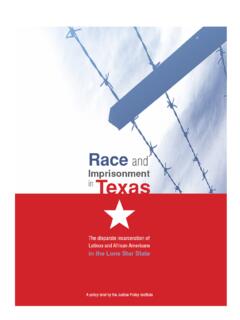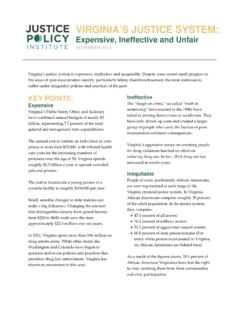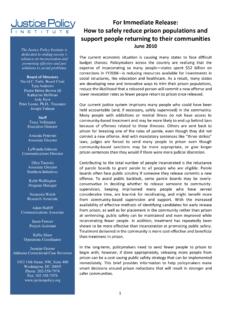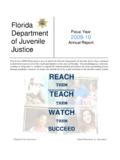Transcription of The Costs of Confinement: Why Good Juvenile Justice ...
1 1 The Justice Policy Institute is dedicated to ending society s reliance on incarceration and promoting effective and just solutions to social problems. Board of Directors Tara Andrews At-Large David C. Fathi Board Chair Katharine Huffman At-Large Peter Leone, Board Treasurer Administrative Staff Tracy Vel zquez Executive Director Debra Glapion Administrative Director Research and Program Staff Amanda Petteruti Research & Publications Associate Nastassia Walsh Research Associate Ellen Tuzzolo Associate Director Southern Initiatives Communications Staff LaWanda Johnson Communications Director Laura Jones Communications Advisor Emily Sydnor Communications Assistant 1003 K Street, NW, Suite 500 Washington, DC 20001 Phone: 202-558-7974 Fax: 202-558-7978 The Costs of Confinement: Why Good Juvenile Justice Policies Make Good Fiscal Sense May 2009 Approximately 93,000 young people are held in Juvenile Justice facilities across the United Seventy percent of these youth are held in state-funded, post-adjudication, residential facilities, at an average cost of $ per day per With states facing serious budgetary constraints, it is an opportune time for policymakers to consider ways to reduce Juvenile Justice spending that won t compromise public safety.
2 This policy brief details how states can see a net reduction in Costs by moving expenditures away from large, congruent care facilities (often called training schools ) for youth and investing in community-based alternatives. Such a resource realignment can reap better results for communities, taxpayers, and children. Evidence is growing that there are cost-effective policies and programs for intervening in the lives of delinquent youth which actually improve community safety and outcomes for children. While there is no silver bullet that will guarantee reductions in crime, policies that include prevention and intervention for youth in the community have been shown to have a positive public safety benefit. Major findings and recommendations for reform include: States needlessly spend billions of dollars a year incarcerating nonviolent youth .
3 States spend about $ billion each year imprisoning youth , even though the majority are held for nonviolent offenses and could be managed safely in the community. The biggest states are realigning fiscal resources away from ineffective and expensive state institutions, and towards more effective community-based services. California, Illinois, Ohio, New York, Pennsylvania, and other large states are redirecting funds once spent on large residential facilities, and spending those dollars on less expensive, more effective programs to curb reoffending and reduce youth crime. Holding more youth in secure Juvenile facilities can lead to costly litigation for states. Unacceptable conditions not only have serious negative consequences on the youth who experience them, but can also lead to court-ordered reforms which in some cases have cost millions of dollars.
4 Imprisoning youth can have severe detrimental effects on youth , their long-term economic productivity and economic health of communities. youth who are imprisoned have higher recidivism rates than youth who remain in communities, both due to suspended opportunities for education and a disruption in the process that normally allows many youth to age-out of crime. See Appendix A for more information on the negative effects of incarceration on Policies that lock up more youth do not necessarily improve public safety. Ten years of data on incarceration and crime trends show that states that increased the number of youth in Juvenile facilities did not necessarily experience a decrease in crime during the same time period. Community-based programs increase public safety. The most effective programs at reducing recidivism rates and promoting positive life outcomes for youth are administered in the community, outside of the criminal or Juvenile Justice systems.
5 Some of these programs have been shown to reduce recidivism by up to 22 percent. Community-based programs for youth are more cost-effective than incarceration. Some programs like multi-systemic therapy and functional family therapy have been shown to yield up to $13 in benefits to public safety for every dollar spent. These programs are more cost effective and produce more public safety benefits than detaining and incarcerating youth . See Appendix B for more information on cost-effective programs that work with youth . Juvenile Justice Definitions Adjudication: The hearing at which the judgment of whether the youth is or is not responsible for the offense he or she is charged with is made. It is the equivalent of the trial in the criminal court process where the guilt or innocence of an adult is determined.
6 Detention: The holding of youth , upon arrest, in a Juvenile detention facility for two main purposes: to ensure the youth appears for all court hearings and to protect the community from future offending. youth may also be detained while awaiting disposition of an adjudicated case. Disposition: Similar to the sentencing hearing the adult criminal Justice system. The judge decides what action or treatment plan to impose upon the adjudicated youth . Residential Placement: After a youth is adjudicated delinquent, the court can order placement in a residential facility. Such facilities can be secure and prison-like or have a more open setting, like group homes or foster care. Secure Residential Facilities: Sometimes also referred to as training schools, residential confinement facilities, or youth prisons, secure residential facilities are for youth who have been adjudicated delinquent to the custody of correctional facilities.
7 These facilities are state-funded are often very large and would be comparable to a prison in the adult criminal Justice system. Status Offense: An offense that would not be considered a crime for adults. Status offenses are offenses that are only illegal for people 18 years old or younger such as curfew violations, running away, truancy, and underage drinking. For details on how to cut Costs in the criminal Justice system, please see the Justice Policy Institute s companion brief, Pruning Prisons: How Cutting Corrections Can Save Money and Protect Public Safety, available at 2 The Costs of Confinement The types and number of offenses being formally handled by the Juvenile court has changed in the last 10 years. In 2005, 28 percent of all delinquent cases handled by the Juvenile court were public order offenses ( disorderly conduct, obstruction of Justice , and liquor law violations).
8 3 This is an increase of 8 percentage points from 10 years And two out of every three (67 percent) cases involved non-person offenses. Despite recent improvements in some jurisdictions, the caseload of the Juvenile Justice system has increased by over half a million cases in the last 20 This increase is not only a burden on an already over-crowded Juvenile Justice system, it is also a detriment to youth who may be better served in the community and without the intervention of the courts. Several theories have emerged as possible causes of the increase in the number of youth processed by the Juvenile Justice system. Among them is the idea that jurisdictions, fueled by assertions that the nation is besieged by young gang members, have expanded policies aimed at regulating youth behavior and strengthening penalties for noncompliance.
9 For example, zero tolerance policies and more police in schools -- policies intended to reduce school violence -- have also increased the likelihood that an incident that previously would have been handled informally or by the school now results in This is contributing to the clogging of an already overburdened Juvenile Justice system. Between 2000 and 2004, for instance, Denver experienced a 71 percent increase in school-based referrals to law Confinement Statistics On any given day, there are more than 90,000 youth in Juvenile Justice facilities across the About 28 percent of youth in these facilities are being detained pre-adjudication or pre-disposition, and 70 percent were sentenced to facilities In 2005, 22 percent of all adjudicated delinquency cases -- over 140,000 youth -- were ordered to a Juvenile Justice placement.
10 Note: Diversion includes youth sent to a residential facility in lieu of adjudication as part of a diversion agreement. Source: M. Sickmund, Sladky, W. Kang, and C. Puzzanchera, Easy Access to the Census of Juveniles in Residential Placement (Washington, : Office of Juvenile Justice and Delinquency Prevention, 2008) Detained26,34428%Committed64,55870%Diver ted1,8652%70 percent of youth in residential facilities are committed by the courtsCurrent trend: More youth are being caught up in the Juvenile Justice system 3 The Costs of Confinement The majority of youth in residential facilities have been adjudicated for nonviolent offenses, including drugs ( percent), technical violations ( percent)* and status offenses ( percent), which include offenses that would not be a crime if committed by an adult.








